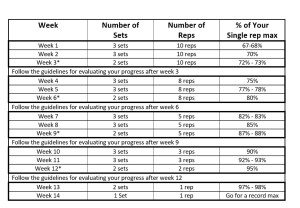Linear periodization has been used by countless champions and multitudes of lifters who have become enormously strong. Some base the amount of weight that they use each week on percentages that are calculated from a single rep max. If you happen to use this method, this article may prove to be very beneficial because a link to a downloadable self-calculating excel spreadsheet will be provided at the end of this article. The spread sheet is based upon the same 14 week linear loading program that was presented in the previous article. When you open the spreadsheet based routine, all you need to do is type in your single rep max for a given lift and the designated percentages for each week are calculated for you so that you don’t have to calculate the percentages yourself.
Percentage based training can be an effective way to communicate the specific training intensity that should be used each week if (and this is a big if) the percentages are based on a single rep max that is very accurate. If not, percentage training can be a disaster. In order to account for this, I believe in a loading system that allows for adjustments as you proceed through the 14 week training cycle. When you use the linear loading program provided, use the following guidelines to make periodic adjustments if necessary:
Guidelines for Adjustments
The Start of a Training Block
You should be able to start each separate three week block of reps using a steady even rep pace for all of the required reps reps. For example, during the first week of the three week block with ten reps, if you can do more than ten reps using a steady even pace, the single rep max that you are using for your calculations is too light and you should add five to ten pounds to it.
In contrast, if you begin your first week of a training block and your rep speed starts to slow down at the end of a set, the single rep max that you are using for your calculations is too heavy. If this happens, decrease the max you are using for your calculations until the percentage listed in the first week allows you to perform the required number of reps using a steady even rep pace for every rep without slowing down at the end of the set.
The Third Week of a Training Block
By the third week of each training block, it should be difficult to perform the required number of reps, but you should still be able to complete the required number of reps. If you can’t, the single rep max that you are using as basis for your calculations is too heavy and you need to decrease it enough to produce a percentage that allows you to complete the required number of reps.
On the other hand, if you are adding weight to the same number of reps for three weeks and still find it easy do the same number of reps during the third week, you must add weight to the single rep max that you are using as a basis for calculating your training percentages.
Every week should have the right feel. The first week of each three week training block should be somewhat challenging, but not so hard that you can’t add weight during the following two weeks. The last week of each three week block should be very challenging while allowing you to complete the required number of reps. If at any point your training is too hard or too easy, don’t wait until the end of the 14 week cycle to make adjustments for the next 14 week cycle. It is better to make adjustments as you go by increasing or decreasing the single rep max you are using for your calculations whenever necessary.
The down load of the 14 week linear loading program is done on an excel spreadsheet, so you must have excel in order to access the download. If you don’t, I will still provide the 14 week training cycle, and you can use the following link (ExRx.net) to calculate the percentages one at a time. For those who have excel, here is a link to the downloadable self-calculating 14 week linear periodization program:
14 WEEK LINEAR PERIODIZATION PROGRAM
The 14 week program is also listed below, but it does not have the ability to calculate percentages for you, it only lists them. Best of training to you.


